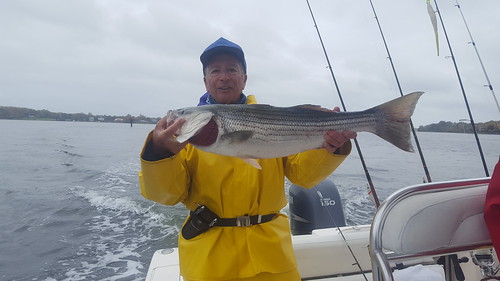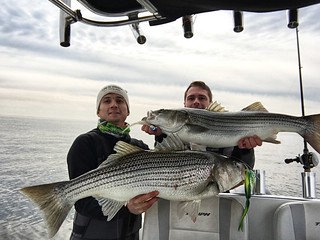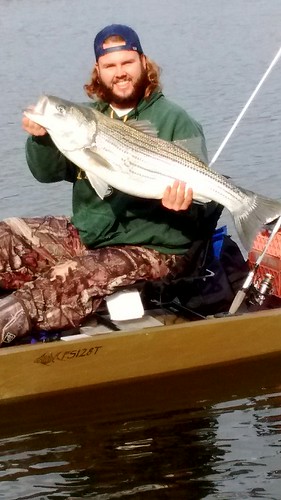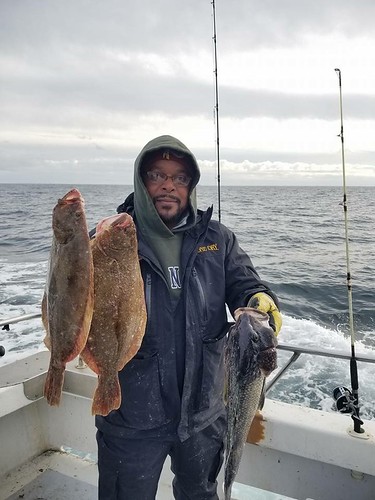Weekly Fishing Report: November 22

Jay Bernstein and friends found some time to get out and jig for a few Chesapeake Bay striped bass. Photo courtesy of Jay Bernstein
Extremely strong winds last weekend made for a tough time fishing on the open waters of the Chesapeake Bay, and kept most boats at the dock. Along with that, a lot of boats were taken from the water and put to sleep for the winter months, now parked and covered in boatyards and backyards.
That being said, weather conditions have been more favorable so far this week. Anglers that can chisel out a little time might be thankful they did, enjoying good fishing for striped bass and white perch.
Before we get into this week’s fishing report, I wanted to remind everyone that they can submit their own fishing reports and photos to the Maryland Angler’s Log. To post a report, please email your name, hometown, photos, location information and additional content for your report. All information is optional, but encouraged. New reports are posted daily during the busy fishing seasons.

Joshua and Jeremy Kaltreider hold up two very respectable striped bass they caught while jigging in the middle bay region. Photo courtesy of Joshua Kaltreider
Water temperatures in the upper bay are ranging from the upper 40s at the mouths of the major tidal rivers to low 50s out in the bay. The larger striped bass over 20 inches are still active along channel edges, but the smaller striped bass that have been so prominent in the past month are less active as they approach the 50-degree temperature mark; this is when their metabolism begins to slow down and they stop feeding.
Light tackle jigging continues to be popular when fish can be found suspended along channel edges or over shoal areas. This time of the year a good depth finder is the most valuable tool on the boat. As most anglers know, diving sea gulls are an obvious indication of feeding fish, but if you happen to be a little late for the party, slicks and sitting birds can indicate action under the surface. Larger soft plastic jigs in pearl with or without silver flash are good choices — some also like a bit of purple.
Trolling has been a very good option and a great way to cover some water. The channel edges in the mouths of the Patapsco, Magothy and Chester rivers have been popular places, as well as the Love Point area. Heavy inline weights are being used to get umbrella rigs and tandem rigged bucktails, parachutes or red surge tube lures down close to the bottom along the 25-foot to 35-foot channel edges. Spoons can be a good option, but care must be taken so they do not get involved with other lines or you will have one heck of a mess.
There continues to be plenty of action at the deeper parts of the Bay Bridge near the bridge abutments and rock piles. Vertical jigging in about 60 feet of water with jigs heavy enough to deal with the currents has been the way to go. The smaller striped bass that were so pesky earlier in the month should start to bow out and hopefully the percentage of larger striped bass will increase per effort. Additionally, there are a lot of large white perch down there at the base of the rock piles, offering some excellent fishing and eating. A small heavy jig with a dropper fly or a substantial sinker with two dropper flies can get down to where the white perch are holding.
In the middle bay region the smaller two- and three-year-old striped bass are beginning to leave the tidal rivers, going deep into the bay where the waters are slightly warmer. The larger striped bass are comfortable with 50-degree water and continue to make life miserable for any baitfish moving down the bay. The steeper channel edges are among the better places to find them suspended as the swift currents sweep the schools of small menhaden, hickory shad and river herring along. Larger soft plastics tend to be the lure of choice and at times one might find breaking fish, slicks or birds sitting on the water to help mark the way. Depth finders will confirm any underwater activity; they are invaluable this time of the year. The mouth of the Choptank River near the False Channel and the Diamonds has been a great place to check out, as well as Eastern Bay and the west side of the shipping channel from Thomas Point south to the radar towers in about 25 feet to 35 feet of water.
As mentioned earlier, trolling can be a good option this time of the year, especially if you’re in a larger boat with a heated cabin. The main channel edges at the mouths of the major tidal rivers and the shipping channel offer a great place to troll. Inline weights will be needed to get lures down close to the bottom where fish are holding. Umbrella rigs, tandem rigged bucktails, parachutes and red surge tube lures have been favorites. Spoons behind inline weights have also been popular.
In the lower bay region, much of the best striped bass fishing tends to be in the lower Potomac and Patuxent rivers and out in the bay along the shipping channel edges. The steep channel edge in the lower Potomac from St. Georges Island down past Piney Point has been holding a lot of nice striped bass. The mouth of the Patuxent has been good and traditional edges along the shipping channel are producing fish at Cove Point, Point No Point and the HS Buoy.
Jigging with large soft plastic jigs has been popular as well as trolling with a mix of umbrella rigs, bucktails, red surge tubes and spoons behind inline weights. The fish tend to be suspended close to the bottom. Some of the fish being caught are 30 inches or better, with most being males.
Everyone is itchy and hopeful that we may see a run of large fall migrant striped bass this year. The main body of striped bass moving south from New England tends to be stretched from Long Island to New Jersey this week and they’re going to have to do some speedy swimming to get into our portion of the bay by close of season on Dec. 20. As we anticipate the arrival of these fish you will often hear stories of sea lice on larger fish being caught in the fall which often turn out to be large resident male striped bass. Gill lice can tolerate low salinities so they are not a good indicator of “sea run” striped bass. Former Department of Natural Resources biologist Rudy Lukacovic wrote a good article about the subject before he retired.
White perch fishing, particularly the larger perch, has been good in all three regions of the bay this week. They can be found in the lower sections of the major tidal rivers, holding in deep water, often in 30 to 40 feet of water over good oyster bottom. A bottom rig baited with pieces of bloodworm is one of the best ways to catch them. Using a heavy but small metal jig with a dropper fly or a sinker with two dropped flies is also a good way to catch them.
Weekly Tidal Fishing Conditions Forecast – Nov. 22-29
This upcoming week of cool, windy conditions will continue to mix bay waters and drive down surface water temperatures, resulting in bay gamefish continuing their movement out of the rivers and into and down the bay. While the Maryland portion of bay is mostly well mixed, bottom waters are a few degrees warmer than surface waters, providing slightly warmer conditions for bay fish. When water temperatures reach about 50 degrees, most blue crabs will have moved to deeper waters and burrowed in the sediment.
The Maryland portion of the bay has a well-mixed water column with suitable oxygen conditions from surface to bottom. However, there are slightly warmer bottom water temperatures, so anglers may want to scan these deeper channel areas for fish. As reported from National Oceanic and Atmospheric Administration buoys, main bay surface water temperatures have cooled down to the mid to low 50s and upper 40s, with the coolest waters found in the upper bay and upper Potomac River near the Woodrow Wilson bridge. The warmer waters are found from the Gooses Reef south to the mouth of the Potomac River. Expect some reduced water clarity from re-suspended sediment in some downwind, nearshore areas as a result of windy conditions. Expect normal flows for streams and rivers entering Maryland’s portion of the bay. There will be excellent tidal currents conditions today through Friday. Windy conditions today through Saturday could impact timing and magnitude of tidal currents.
For the full weekly fishing conditions summary and more detailed and up-to-date fishing conditions in your area of the bay, be sure to check out Eyes on the Bay’s Click Before You Cast. Since this is a new feature for Chesapeake Bay anglers, drop us a line with comments or suggestions.

Aaron Watkins was fishing in Rocky Gorge recently for striped bass and caught and released this beauty. Photo courtesy of Aaron Watkins
The Deep Creek Lake area was hit with snow again last weekend along with continuing cold temperatures. A drop in water temperatures has created good fishing conditions for walleyes for boat or shoreline fishing. Casting jerkbaits that are rigged to dive have been a good tactic in the evenings around steep rocky shores or similar deep structure. Fishing with minnows under a slip bobber is another good way to fish for a mix of walleye and yellow perch.
The upper Potomac River was running high earlier this week, but is in good condition now for smallmouth bass and walleye fishing. Water temperatures tend to be a bit cool for smallmouth bass – often, fishing success will increase as the sun rises in the sky and warms things up. Walleyes, of course, relish this colder water, and are very active. Tubes, small swim baits and hair jigs are all good choices to fish current breaks and submerged ledges.
Fishing for trout remains a viable option for freshwater angling this week. There are still some holdover trout in the put-and-take areas, but the catch-and-release trout management waters offer the most fun this time of the year. Many of these areas are limited to fly fishing only and offer the chance to flex your fly rod and enjoy the thrill of catching and releasing some healthy and beautiful trout.
Some of the freshwater reservoirs in Maryland, such as Liberty and Rocky Gorge, are stocked with landlocked striped bass. The early spring and late fall tend to offer the best opportunities to fish for them since the larger striped bass enjoy the cooler water temperatures.
Fishing for crappie remains very good this week in many impoundments across Maryland and most tidal rivers. The crappie are schooling up near deep structure such as bridge piers, marina docks and fallen tree tops. The Nicodemus fishing bridge alongside the highway bridge at Liberty Reservoir is an excellent place to fish for crappie, as are St. Mary’s Lake in southern Maryland and the tidal Potomac below the Wilson Bridge. A bobber with a minnow, small grub or crappie jig is a great way to catch them.
Colder water temperatures are causing largemouth bass to hold deeper in transition areas near structure such as sunken wood. These fish are usually close to the bottom picking off crayfish and small baitfish headed for deeper cover. Hair jigs, small crankbaits, spinnerbaits and grubs are all good lures to use. A slow retrieve close to the bottom is a good tactic — the pickup will be subtle. Chain pickerel love this colder water and the upper reaches of many of the tidal rivers feeding into the Chesapeake are great places to fish. Many impoundments have good populations of chain pickerel also, such as Deep Creek Lake, St. Mary’s Lake and Smithville Lake, which is a tributary of the Nanticoke River in Caroline County on the Eastern Shore. Many of these places to fish can be found on the freshwater fishing hot spots site.
Water temperatures near the Ocean City Inlet are holding around 52 degrees this week and the coastal fishing scene continues to transition towards cold water species. In the surf there are still kingfish being caught on bloodworm baits and small bluefish are being caught on cut bait. At the inlet, tautog are the main target and some nice legal-sized fish are being caught along the south jetty and the Route 50 Bridge area. Pieces of green crab or sand fleas have been the baits of choice. A few sheepshead are being caught on sand fleas. Flounder are still being caught as they move through the inlet and head offshore. Fishing for striped bass has been a fun venture at the inlet and Route 90 Bridge area. Most are a bit short of the 28-inch mark but they offer a lot of fun topwater fishing opportunities.
Outside of the inlet, boats heading out to the wreck sites are finding limit catches of sea bass for their rail huggers with a nice mix of triggerfish, flounder and bluefish as well. A few hardy souls have been traveling out to the canyons to fish for swordfish and to deep drop for tilefish with good results.
“Left to his own natural instincts and common sense, any man of reasonable intelligence and sensibility is likely to favor bottom fishing above all other forms.” -Louis D. Rubin Jr.
 ABOUT THE AUTHOR Keith Lockwood has been writing the Fishing Report since 2003 and has had a long career as a fisheries research biologist since 1973. Over the course of his career he has studied estuarine fishery populations, ocean species, and over a decade long study of bioaccumulation of chemicals in aquatic species in New Jersey. Upon moving to Oxford on the eastern shore of Maryland; research endeavors focused on a variety of catch and release studies as well as other fisheries related research at the Cooperative Oxford Laboratory. Education and outreach to the fishing public has always been an important component to the mission of these studies. Keith is an avid outdoorsman enjoying hunting, fishing, bird dogs, family and life on the eastern shore of Maryland.
ABOUT THE AUTHOR Keith Lockwood has been writing the Fishing Report since 2003 and has had a long career as a fisheries research biologist since 1973. Over the course of his career he has studied estuarine fishery populations, ocean species, and over a decade long study of bioaccumulation of chemicals in aquatic species in New Jersey. Upon moving to Oxford on the eastern shore of Maryland; research endeavors focused on a variety of catch and release studies as well as other fisheries related research at the Cooperative Oxford Laboratory. Education and outreach to the fishing public has always been an important component to the mission of these studies. Keith is an avid outdoorsman enjoying hunting, fishing, bird dogs, family and life on the eastern shore of Maryland.
Want the Weekly Fishing Report sent right to your inbox? Click here to sign up!

